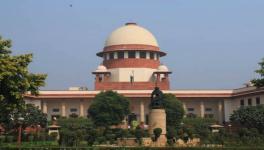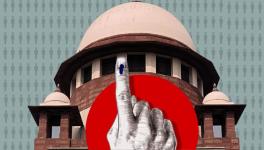SC-Appointed Committee Bats for Adani in Hindenburg Case

The SC-appointed committee’s report itself exposes the limitations it faced.
From the time the Supreme Court appointed an ‘expert’ committee to carry out a review of the SEBI’s (Securities and Exchange Board of India) regulatory actions in relation to the Adani Group following allegations raised by the Hindenburg report in January, fears had been expressed that the exercise may be designed to exonerate the Adani Group. The antecedents of and positions expressed by the committee’s members were subjected to public scrutiny in this light.
The completed report by the committee, which has circulated among the press since May 19, may turn out to vindicate those fears. Without implicating or exonerating the Adani Group, the committee’s report lays out a legal theory that ends up forming the perfect argument for Adani to defend itself against allegations of stock price manipulation, violations of securities law on declaring transactions with “related parties” and using shell companies in tax havens to evade stock market rules on minimum public float.
Much discussion since the report’s contents being revealed in the media has focused on whether it gives Adani a ‘clean chit’. The report itself however is crafted in a way that serves both answers. Where Adani’s critics and India’s political opposition are concerned – the answer is ‘no.’ Congress spokesperson Supriya Shrinate on the evening of May 19 pointed out that the report provides no answer to the question it has been raising, that is, what is the source of 20,000 crore rupees of funds that were invested into the Adani Group’s listed companies by opaque entities registered in tax havens? On the other hand, the Adani Group itself has sought to portray the report as an exoneration. Its PR messaging has emphasised that the report has not found the group to have broken market rules or engaged in stock price manipulation.
In fact, the committee was not entitled to implicate or exonerate the Adani Group, to begin with. Its specific remit assigned by the Supreme Court was to determine whether or not there had been a regulatory failure on the part of the SEBI and recommend ways to improve the SEBI’s conduct of regulatory oversight. On various occasions in the 173-page report, the committee pays lip service to this limitation on its remit, making a show of declining to pass judgment on issues that are under investigation or that are being debated concurrently before the Supreme Court bench. In fact, the report serves to exonerate SEBI, finding that it cannot be accused of regulatory failure.
However, in doing so, the committee has ended up formulating a legal theory concerning the underlying facts of the allegations against the Adani Group, which serves to undermine SEBI's ongoing investigation into the group and its mysterious foreign benefactors. While constituted as a body to evaluate the SEBI’s role as a regulator, the committee has virtually assumed the effective role of a third-party advocate making a case for the Adani Group’s innocence before the Supreme Court. Whether or not its arguments are accepted, the report’s argument may end up setting the terms of the issues at hand in the larger case at the Supreme Court.
The Committee does this by providing arguments for why the 13 suspect foreign portfolio investors (FPIs) registered in Cyprus and Mauritius that are heavily invested into the Adani Group do not qualify as “related parties” to the Adani Group’s promoters, and that their declarations of Ultimate Beneficial Ownership were compliant with disclosure requirements despite the SEBI seeking to lift the corporate veil and identify their sources of funds beyond the formal declarations. While examining these issues in the context of evaluating whether SEBI acted appropriately in its function as the regulator of the securities market, the committee arrives at conclusions that far exceed the regulatory issue and end up constituting pronouncements on Adani’s potential culpability.
Let us consider the two main issues.
At the heart of the allegations are a group of 13 firms registered offshore that are heavily invested into the Adani Group’s listed shares. Twelve of the 13 are registered in Mauritius and one is registered in Cyprus. The Hindenburg report alleges that these entities are proxies for the Adani Group’s promoters. The committee report affirms that the SEBI has also suspected the same and has been investigating the issue since October 2020. If it can be proved that these firms are indeed proxies for the Adani Group or its promoters, then that would imply at least two categories of potential violations. The first would be a potential violation of minimum public shareholding (MPS) rules, where listed companies are required to have at least 25% of their shares held by the public. Then would be the question of whether transactions with these firms would qualify as “related party transactions”, which listed companies must declare.
The committee however heads both these issues off.
For the MPS issue, the committee considers the language contained in the SEBI’s rules for Foreign Portfolio Investors (FPIs) concerning the definition of “beneficial owner” or “ultimate beneficial owner.” It notes that the FPI rules contained a separate clause defining the term that was amended a number of times until 2019. Then, the clause was removed from the rules and the term was assigned the definition used in the Prevention of Money Laundering Act (PMLA). Since 2019, therefore, the committee argues, that beneficiary ownership declarations by FPIs needed to comply with the definition in the PMLA.
Then the committee argues, the 13 offshore firms were indeed compliant under the definition of the PMLA, as they had provided the names of their fund managers as the beneficiary owners.
Crucially, the disclosure requirements under the PMLA are less strict than those earlier prescribed by the SEBI’s FPI rules. The FPI rules were structured in a way to ensure that every controlling interest in an FPI is captured in the beneficial ownership declaration – from the fund manager to those who have high stakes in the fund, to the beneficial owners of those high stakeholders – leading all the way up the chain to identify whose funds were ultimately being invested by the FPI. Meanwhile, the PMLA definition did not require such detailed disclosure – allowing the funds to be compliant just by naming their fund managers.
Then, the committee holds, since the funds were compliant on paper, the SEBI investigation into whether these funds can be established to have ultimately acted as proxies of the Adani Group is a matter of whether the “spirit of the law” has been violated, rather than the letter of the law. While the committee expressly declines to comment on the findings of the ongoing investigation it has effectively formulated a legal opinion that would end up invalidating any eventual findings.
The committee’s report seems to treat the SEBI’s inability to get other agencies, both Indian and international, to cooperate with its investigation as a demonstration of the lack of a prima facie case and then treats this as a statement of fact by fait accompli. It notes that the SEBI has been able to acquire the names of 42 investors in the 13 offshore firms and that these are all companies registered in yet more tax havens – the Cayman Islands, the British Virgin Islands, Malta, Curacao, and Bermuda. It then notes that the SEBI has been able to obtain information on the controlling stakeholders and investors of 24 among the 42, but has been struggling to obtain the rest. It reports that the Enforcement Directorate and the Central Board of Direct Taxation have declined to support its requests to join the SEBI’s investigation and that international coordination mechanisms to obtain information from the market regulators in the offshore jurisdictions have also failed. Then it turns this around onto the investigation itself, effectively arguing that the SEBI’s failure to make a case justifying its requests to the various other agencies implies that no prima facie case exists. It terms the investigation by the SEBI that could determine the true source of the funds invested by the 13 FPIs as a “voluminous exercise” and implies that it would constitute a fishing expedition.
Suppose the SEBI does succeed in unearthing a money trail proving that the Adani Group’s money was indeed funnelled through these firms back into its own companies – the committee’s argument implies that conducting such an investigation may itself be illegal and that this would still not constitute a violation, as the firms were compliant with the PMLA’s beneficial ownership declaration standards.
Is this opinion correct, and was it correct for the committee to express this view? This would normally be a matter of dispute by the petitioners and the Adani Group directly. Questions that could arise, for instance, would involve the period of time when the firms were invested into the Adani Group’s listed companies, and what declaration requirements were applicable at which time. The entities could conceivably have fallen in and out of compliance as the declaration rules changed. This discussion is precluded by the committee’s report, however, as the SEBI investigation is ongoing. How appropriate was it for the committee to have expressed such a view at this stage?
A similar issue arises with the committee’s treatment of the question of related party transactions. Here, the committee engages in a discussion of the evolution of the SEBI’s policy with regard to the definition of the term “related party.” It begins by pointing out that the SEBI Act contains a clause that outlaws “contrivances and devices that are structured to circumvent the law”. Then it says, this broad anti-avoidance clause was effectively nullified by the SEBI introducing various specific rules dictating the definition of a related party over the years. By notifying a specific definition of a related party – the committee says – the broader anti-avoidance stricture is inapplicable to entities and transactions that are not classifiable as related parties under the SEBI’s definition.
This, then, leads the committee to imply that a particular set of transactions that the SEBI is investigating are all unclassifiable as related party transactions under the letter of the law even if they are found to have been carried out with entities acting on behalf of the Adani Group. Since the disclosure requirements specified under the SEBI’s definition of the related party did not necessitate those transactions to be reported and those entities to be declared as related parties – the committee says there has been no violation of related party disclosure rules.
Once again, this is a legal interpretation that one would expect to be the domain of the Supreme Court’s bench, and not the committee’s. Does the SEBI Act’s broad anti-avoidance clause apply if a SEBI investigation finds that undisclosed transactions were indeed with related parties? Can the entities be declared related parties if they are found to be “contrivances or devices structured to circumvent the law” despite not meeting the SEBI’s notified definition? This would be an issue for the SEBI and the Adani Group to litigate, ordinarily.
The other sections of the committee’s report, which often reiterate recommendations made by various government committees and working groups over the years for institutional reform of the SEBI and the broader system of financial market governance, while no doubt valuable, have no bearing on the Adani issue at hand.
Taking a step back, while the committee may have overstepped its bounds by expressing opinions on the factual matrix in the Adani case, this report is emblematic of the limitations of the way in which the scandal around the allegations made by Hindenburg Research has been handled by the Indian system. While the opposition has demanded an investigation by a Joint Parliamentary Committee (JPC) which would be empowered to take a holistic view of the allegations, the case that is proceeding before the Supreme Court has so far had a narrower scope.
The committee’s report itself exposes the limitations it faced. It notes that it was unable to receive testimony from a number of individuals, firms and banks, despite requesting them to appear before the committee. The committee had no means of compelling a response to a summons, while a JPC would be far more empowered. It was outside of the committee’s remit to carry out any investigative functions of its own. So, when the SEBI reported to the committee that it had found no technical evidence of stock price manipulation by the 13 offshore firms, the committee treated this as effectively closing the question of stock price manipulation altogether. In fact, the SEBI also told the committee that the Life Insurance Corporation of India (LIC) was the largest buyer of shares of Adani Enterprises Limited from April to December 2021, when its price zoomed from Rs. 1,031 to Rs. 3,859 as LIC picked up 4.8 crore shares. Did the LIC’s concerted buying push up the price? Why did the LIC execute this large investment? These are questions that the Congress spokesperson Shrinate also raised, and it would have no doubt been something a JPC could have followed up on. This is aside from the fact that, without having access to the financial records of the 13 firms and their investors, the SEBI cannot definitively speak to their moves on the Adani Group’s shares, having to rely at this stage only on technical analysis of trade volumes.
The committee’s report suggests that temporary investigative task forces can be set up with personnel drawn from across India’s law enforcement and regulatory agencies to investigate issues of “systemic importance” such as the Adani-Hindenburg allegations. In practice, the government and the Supreme Court both have the power to constitute Special Investigative Teams that play the same role. Parliament has in its power the ability to set up a JPC, which can also carry out investigative functions. By making such a suggestion, the committee has in fact drawn attention to the lack of teeth in its own and in the SEBI’s investigative powers. Why could the government or Parliament not set up an adequately empowered investigation within existing frameworks? Why did it fall on a court-appointed committee that reviewed the SEBI’s regulatory actions, to suggest such a measure?
In Parliament, the opposition has also alleged that the Adani Group has been favoured by the Modi government in numerous ways, an allegation that a JPC could tackle but which has not been entertained by the Supreme Court so far. Multiple other probes into allegations against the Adani Group by the Directorate of Revenue Intelligence (DRI) and the Central Bureau of Investigation (CBI) form parts of the issue that are not among the subjects being considered by the Supreme Court. Information already in the public domain, for instance, suggests that the DRI’s investigations into alleged over-invoicing in imports of coal and thermal power generation and transmission equipment by the Adani Group may be relevant to the question of whether the offshore firms are linked to the Adani Group. The DRI’s investigation had alleged that proceeds of the over-invoicing scheme were being “round-tripped” back into India in the form of FPI investments into Adani Group companies, and had unearthed a part of a network of offshore firms that it alleged to be related to the Adani Group promoters. None of this information has been considered by the Supreme Court yet, nor was it considered by the expert committee.
For now, the committee’s report raises the possibility that the Supreme Court case may ultimately turn into exoneration of the Adani Group from any wrongdoing on the narrow and specific set of issues related to the legal status of the offshore firms, without examining the larger range of issues raised by the scandal.
The author is an independent journalist based in Bengaluru.
Get the latest reports & analysis with people's perspective on Protests, movements & deep analytical videos, discussions of the current affairs in your Telegram app. Subscribe to NewsClick's Telegram channel & get Real-Time updates on stories, as they get published on our website.
























